The Best New York Style Pizza Dough and 14 Tips for Success!!
I’ve been making a lot of this NY style pizza dough recipe …. The obsession started a while back, and I’ve finally found a recipe that I love the best! After years of experiments (and I mean years!), I am now using this recipe based on recommendations from the many fine pizza makers at www.pizzamaking.com and the late great Dough Doctor, Tom Lehmann.

Making Pizza Dough at Home
Making NY style pizza dough is definitely somewhat of an art form. There are so many variables that can be changed aside from the ingredients alone. For example, these variables include:
- oven temperature
- temperature of the water used to make the dough
- proofing methods (room temp vs cold rise)
- order of adding the ingredients (yes, this makes a big difference!)
- mixing time
- use of autolyse
- use of poolish (I don’t do this or the one before, although I have in the past)
And then of course, the toppings which can be simple or as complex as you’d like. But don’t worry too much about all of this – my method is easy and straightforward. Plus, you will make better dough than 99% of the pizza chains out there. You will not want take out anymore!
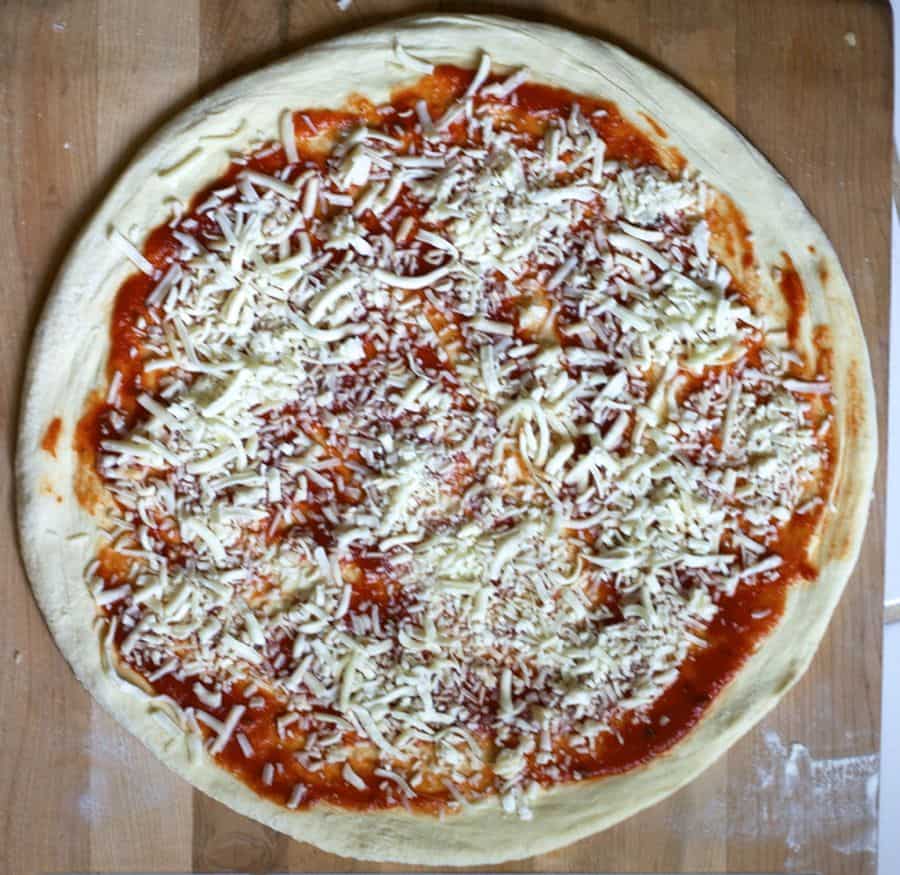
My Favorite Pizza Dough: The Big Secret (How You Proof the Dough)
My all-time favorite dough is NY style dough, which really is classic pizza dough that is stretched out into a thin crust pizza. This type of pizza dough contains water, flour, salt, instant yeast, and olive oil (and sugar especially when baking in a home oven, to help browning).
After it is mixed, it is proofed (left to rise/ferment) in the refrigerator for a minimum of 24 hours and up to 72 hours (it can also be frozen) – this is the big secret. I’ve used the dough up to 5 or 6 days afterwards, so you can essentially prepare dough for the week.
This recipe produces a crisp yet foldable crust that is tender, light, and flavorful and will make enough for four 14-inch pizzas. You can easily double or half the recipe to make 2 or 8 pizzas.

Fourteen Tips for Success
Tip 1: Choosing the flour
Use high-quality flour – I like to use King Arthur’s all purpose or bread flour; higher protein (ie, bread) flours work best. However, I prefer all-purpose flour because I like a lighter, airy crust.
Tip 2: Adding the yeast
Do not add instant dry yeast (IDY) directly to cold or cool water – you may shock the yeast (add the IDY to your flour instead) (please note that IDY differs from active dry yeast, which must be activated by adding it to water).
Tip 3: How much yeast?
Use only enough yeast to “get the job done” – yeast eats the sugar in your flour to produce its leavening effects – I find that if you use too much, your dough will be tasteless (this is just my opinion); however, it is a fact, that too much yeast can make your dough taste bad. Most recipes out there, some of them in well known, published books contain too much yeast!
Tip 4: Cold ferment that pizza dough!
Always use your refrigerator. The best NY style doughs “ferment” or “cure” in the refrigerator for at least 24 hours and up to 48 72 hours. This is called a “cold rise” (vs warm rise on your kitchen counter).
The refrigerator is used to retard (or slow) the dough’s fermentation, allowing that distinctive flavor to come through (ever wonder why some pizza crust tastes different than others, despite the fact that they are both made from just about the same exact ingredients? – this is a big reason why!)
When your dough rises too quickly, the flavor will not develop optimally. Slow rise = MUCH better flavor.
Tip 5: Weigh those ingredients!
Use a scale to weigh the flour instead of using a measuring cup – it is much more accurate and will yield superior results. I’ll admit, I resisted doing this for a loooong time. Just do it. You’ll be glad you did and your dough will be more consistent and much improved.
Tip 6: Add oil last
Mix the oil in as the last step, after the flour has all been incorporated. This is important to allow the flour to hydrate properly.
Tip 7: Flour your dough balls
Before tossing or opening your dough balls, flour them *very* well on each side (if you are a beginner) to ensure they do not stick to your counter or pizza peel. I sometimes use a bit more flour after I begin spreading them.
Tip 8: Keeping those rims a bit puffy
Take care not to “degas” the rim of your pizza as you are spreading your dough! Do NOT ever use a rolling pin! There are many different methods to spread/open your dough ball. I hope to add a few pictures someday of this process.
Tip 9: Baking pizza in a home oven
Ensure that your oven is preheated for a sufficient amount of time (about 1 hour) and bake the pizza within 6 to 8 inches of the top of your oven (ie, your broiler) so that the tops browns sufficiently in conjunction with the bottom of the pizza.
Do not place the stone near the bottom of your oven. I made this mistake for too many years.
After your stone has been preheated sufficiently, the heat from the stone will cook the pizza from the bottom and you can switch the broiler on if you find you need more browning on the top (I now use the broiler to bake my pizzas…more on this sometime in the future).
If you find that your cheese is browning well before your rim attains sufficient color, use partially frozen cheese (ie, place shredded cheese in the freezer while the oven is heating up) and cold sauce or you can drizzle just a bit of olive oil on top of cheese.
Tip 10: Use a pizza stone or steel
Use a pizza stone if you have one. The stone with draw moisture out of the dough and produce a beautifully crisp crust. I use a pizza steel because my stones kept breaking.
Tip 11: Use just the right amount of sauce
Do not use too much pizza sauce – it will make your pizza soggy
Tip 12: Find the right kind of cheese
Do not use low fat cheese to top your pizza or pre-shredded cheese (the former will not melt sufficiently and the latter contains additives that prevent the cheese from sticking together and therefore does not melt very well). The best is low-moisture, whole milk mozzarella.
If you must use pre-shredded cheese, I’ve found that adding the sauce on top of the cheese helps with the melting. Also, do not use too much cheese; apply it sparingly so that you can achieve that mottled NY pizza appearance.
Tip 13: Flour your pizza peel
Use semolina or flour on the bottom of your pizza peel to prevent the pizza dough from sticking but be careful not to overdo it because it will burn.
Tip 14: Learn to launch that pizza
Give the pizza peel a few very small quick jerks to make sure the pizza will easily slide off your pizza peel before attempting to transfer pizza to the oven, and more importantly, rub flour into the peel before placing the dough on top.
Essential Equipment
Please note that as an Amazon affiliate, we earn a small commission if you purchase a product at no additional cost to you.
I adore my baking steel; it’s transformed my home pizzas into restaurant-quality and better. You will love this! A kitchen scale streamlines measurement with remarkable accuracy, while a pizza peel is essential for smoothly sliding pizzas into the oven. And proofing boxes provide an optimal storage for pizza dough fermentation, enhancing flavor, texture, and elasticity.
Please visit our SHOP page for more recommended tools and equipment to make restaurant-style NY-style pizza at home!
How to Stretch the Pizza Dough
A nice video (from The GoodFellas Pizza School of NY), showing how to stretch the dough:

How to Freeze Homemade Pizza Dough
- After mixing dough and dividing into balls, place dough in refrigerator for at least 24 hours.
- Place dough balls on baking sheet lined with plastic wrap or parchment paper, cover loosely with plastic wrap and freeze until firm (~ 2 to 3 hours or up to overnight).
- Wrap frozen dough balls individually in plastic and store in zipper-lock bags for up to 4 weeks.
- When ready to bake, transfer unwrapped dough into the refrigerator for 12 to 24 hours before making pizza.
- Bring dough to room temperature for 20 to 60 minutes before baking (less time for hot kitchen/summer and more time for cool kitchen)
Pizza Dough Calculator
Need more dough? Less dough? Try out our new Pizza Dough Calculator to calculate the weights to get it just right!
Have More Questions?
Please See My NY Pizza FAQ
If you tried this recipe, please leave a 🌟 star rating and let me know how it went in the 📝 comments below! SUBSCRIBE for more recipes.
📖 Recipe

The Best New York Style Pizza Dough
Equipment
- pizza stone or pizza steel for baking
- Standing mixer optional or hand knead
- kitchen scale highly recommended instead of volume measures
Ingredients
Original Recipe for Four 14-Inch Pizzas; want to make more or less? Use the pizza dough calculator
- 6.5 cups (796 g) all purpose flour or bread flour (weighing is most accurate!)
- 2 1/4 cups (493 g) water barely cold water (17.4 oz per 2 1/4 cups)
- 1 teaspoon (3.5 g) instant dry yeast
- 2.5 teaspoons (15.6 g) salt
- 2 teaspoons (7.8 g) sugar
- 1 tablespoon (11.8 g) olive oil
1 Pound of Dough (~454 grams) (use the pizza dough calculator to make more or less dough)
- 2 1/4 cups (274.5 g) all purpose flour or bread flour
- 3/4 cup (170.2 g) water
- 1/2 teaspoon instant dry yeast
- 1 teaspoon salt
- 3/4 teaspoon sugar
- 1 teaspoon olive oil
Instructions
Mixing the Dough
- Place water in mixing bowl.
- In a separate bowl, mix salt and yeast (and sugar if using) into flour
- Combine flour/salt/yeast mixture into water and mix until all the flour has been incorporated.
- After flour has been totally incorporated, add oil and knead for about 4 to 5 minutes (see note)
- Test final dough temperature, which should ideally be between high 70s to low 80s (optional)
Dividing and Rising
- Divide dough into 4 equal pieces (using a digital scale if possible; each ball should weigh 11.5 oz [~326 grams]), shape into a ball, and place in greased, sealed quart-sized container or oiled/greased freezer bag and refrigerate overnight or up to 72 hours (After much experimenting, I have concluded that I like 3 days best but day 2 is good too).
Assembly and Baking
- The following day, remove your dough balls within 1 hour or less of baking and allow the dough to come to room temperature. (the dough will tend to blister more if the dough has not been allowed to come to room temperature however, I often bake coldish dough without problems, just some bubbling)
- In the meantime, place your pizza stone in oven and preheat at 550 degrees (depending on thickness of your stone and your oven’s power) for at least 1 hour
- Open each dough ball using care not to degas, transfer to a pre-floured pizza peel (or on parchment paper), and top with your favorite sauce, cheese, or other toppings.
- Transfer pizza from peel to oven or slide parchment paper onto preheated pizza pan/stone and bake for 4 to 6 minutes each until browned on top and cheese has melted but not burned.
- Enjoy!
Notes
- Use of weight based measurements is highly recommended instead of US Customary. You will need a kitchen scale.
- METRIC amounts DO NOT correspond exactly to the US Customary amounts because, for example, 796 grams equals 6.4 cups (and most can’t measure 0.4 cups or 0.22 cups). Recipe was based on grams.
- Use the Pizza Dough Calculator
- If you want to use the dough the next day, knead a little more (slow speed for about 8 to 10 minutes)
- If you have time to let the dough rest for 3 days, knead for 4 to 5 minutes, low speed or hand knead.
- After mixing dough and dividing into balls, place dough in refrigerator for at least 24 hours.
- Then, place on baking sheet lined with plastic wrap or parchment paper, cover loosely with plastic wrap and freeze until firm (~ 2 to 3 hours or up to overnight).
- Wrap frozen dough balls individually in plastic and store in zipper-lock bags to store for up to 4 weeks (longer may work, but results might vary).
- Before using, transfer unwrapped dough into the refrigerator for 12 to 24 hours before making pizza.
- Bring dough to room temperature for 20 to 60 minutes before baking (less time for hot kitchen/summer and more time for cool kitchen).
- calculate your own using baker’s percentages: 62% hydration, 0.4% yeast, 2% salt, 1.5% oil, and 1% sugar or use my new pizza dough calculator.
Nutrition
Try these other pizzas and this NY pizza sauce:
Buffalo style (one of my absolute favorites)
White with prosciutto
White with spinach and feta
Pizza sauce

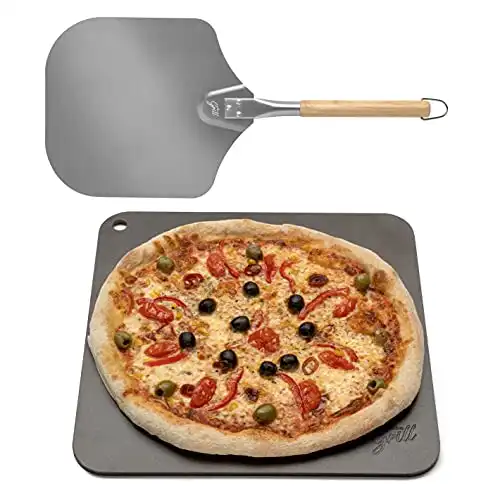
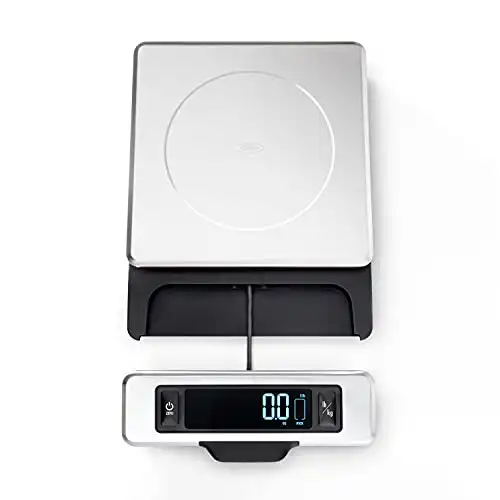
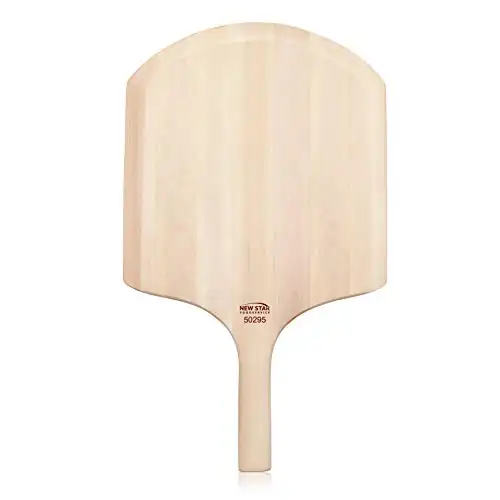
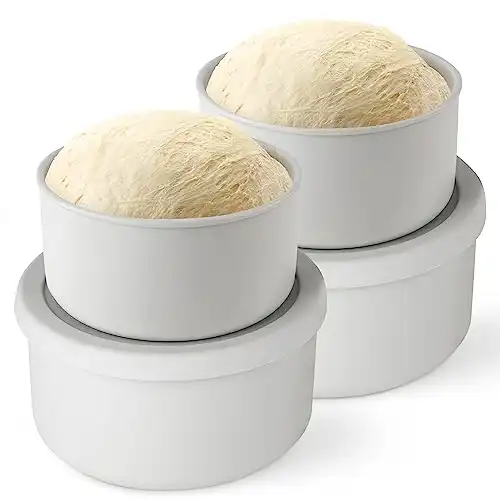
HI Marie,
recipe sounds great and real easy to work with! I have a question: how big the dough should rise in the fridge?? I have separated it into four containers and they’ve been resting in the fridge for about 16 hours now. The dough is fitting two out of the four containers rather snugly, the other two somewhat less. I didn’t expect them to come this high because of the low temp in the fridge. Is this normal?
I’ll let you know how they come out though, I’ll be baking them tomorrow or the day after.
A small ‘editorial’ suggestion for the recipe (for easy of use to non-US folks like myself :)) Is there a way to convert the amount of water into milliliters instead of grams? I used a scale all right to measure it but it was a tad weird weighing the liquid in grams instead of milliliters. Overseas we use grams for solids and milliliters for liquids, would be a nice touch to make the recipe more internationally ‘adaptable’ 😉 Just a thought…
Hi Petra – the dough does rise a bit and sometimes mine also rise out of the container depending on how much room there was to begin with and so that is a tough question to answer but if you followed the directions and measured correctly, the dough will be good! Also thanks for the editorial suggestion. I always thought that 1 g = 1 ml, so conversion should be easy, no?
Hi Marie,
I’m planning on making pizza this weekend and was hoping to make the dough in my stand mixer tomorrow so that i allow for it to rise in my refrigerator for a good 72 hours before baking. My question is once the dough has formed is it absolutely necessary to divide it in 4 balls and refrigerate? Do you think it will affect the process if i just put the entire dough ball in a greased larger container? Also, should i keep the container lids cracked open a bit or is it ok if its a good tight seal?
In the past i’ve been this thin crust style pizza a friend had shared with me but ive really been craving that ny style crust that is not too temperamental.
Akta
Hi! I’ve never done it that way, but I think it can be done. After all, that is how bread is made. You do a bulk rise, then divide and rise again. In this instance, the bulk rise would be in the refrigerator and then you would divide into balls and let them rise a bit before/while the oven heats up. Time would depend on ambient temp but I’d say 1 to 1.5 hours or so…Good luck!
Thanks…I think i’ll just put the doughs in 4 tupperware containers that i have and it’ll save me the hassle of separating them out later. One quick question, I’m a little confused on how long to refrigerate the dough? I think you mentioned 3 days (72 hours) in your blog but you also mentioned 2 days in your responses to other viewers.
Thanks again
You can use it anywhere from 1 to 3 days in the fridge. It’s really a matter of taste since the dough continues to develop flavor as it ferments in the fridge.
Thank you for this recipe!!! Just finished polishing off my first pizza from this recipe and was very happy with the result. Have been bemoaning the fact that my homemade pizza was a pretty sad imitation of the “real” thing for a long time. No more 🙂
This sounds amazing & I can’t wait to attempt it…. Do you have any pizza sauce & cheese recipe/brand recommendations? Thanks in advance!!
Hi Katie – I have a pizza sauce recipe here on the site. For cheese, try to get a low-moisture, whole milk mozzarella. The skim versions burn very easily. Hope that helps!
Thank you! I’ll definitely look at that recipe.
Great recipe- my family loves it. Could uou please clarify something
You mention taking the dough out 1 hour or less before baking, but then say to let it come to room temperature. It usually takes more time than 1 hour to come to room temp. Which is more important ; to stick to the less than 1 hour time or look to get to room temp?
Hi Brett – I have even used the dough while it was still cold many times (it’s a bit more challenging to stretch though). What you don’t want to do is wait so long that the dough collapses and becomes overproofed. Hard to say when that would occur because it’s related to the temp in your kitchen but it’s probably something to look out for on a very hot day. So regarding the 1 hour rule or reaching room temp, it’s really just a guideline so that folks don’t leave the dough out for too too long…
I love this pizza dough recipe. It works so well and makes a great pizza. However, I’ve started a sourdough starter, and I’m trying to find a pizza dough recipe which uses the yeast in sourdough to raise the dough rather than added instant yeast. Have you ever adjusted this recipe to use a sourdough or do you have any recommendations for sourdough pizza dough recipes? Thanks!
Hi Caitlin – I love sourdough pizza too! I haven’t made it in a while but I used to use Jeff Varasano’s recipe. It’s very good!
Thank you Marie! I am a ‘pizza baker newbie’ and tried your recipe. It was fantastic! Looked just like your picture and tasted just like slice from a NY pizzeria. I made a half batch (2 pizzas) and placed the dough in the frig for @ 30 hours. My only question: I let the dough sit out at room temperature for 1 hour. However, when I tried to shape either dough ball, both were extremely springy…to a point where I had to use a rolling pin (I know NOT recommended). Every time I tried to stretch the dough, it would spring back into original ball shape. Any advice? I used King Arthur Bread Flour and weighed all the ingredients. I also included sugar. I used a KitchenAid mixer with a hook and kneaded the dough for @ 10 minutes.
First, I would recommend trying King Arthur all purpose flour next time and see if that’s easier. It has a higher protein content than most other all purpose flours but a bit less than their bread flour. I recommend bread flour on the site because many all purpose flours aren’t really ideal for pizza but King Arthur all purpose definitely is. Alternatively, you can usually let the dough ball rest a bit after trying to stretch it and it helps relax the gluten. Also, when mixing your next batch, you can place all the yeast, water, and flour in the mixer and mix until flour has been incorporated then let rest for about 15 minutes before adding salt, oil, sugar and then continue mixing for the additional time. Hope that helps!
hi Marie. You are so correct. I am sure that if I cook crust only with no sauce/toppings that the air pockets will probably happen. Never even thought of that. Thank you for forewarning me. I, as well, don’t think that pricking the crust is what I want to do (but who knows, I may try on a little piece of pizza dough). I will go back to precooking a couple pizzas and then also make a couple fresh as per your suggestion. Until next time, have a great week!
Thank you for the recipe, the dough is perfection. My only question is what procedure do you use to cook your pie. I feel like I do not get enough heat on my pizza stone. I tried using the broiler to increase the heat as well as setting the temperature to 550 degrees (The maximum temperature of the oven). I want to get my dough to be a little bit crisper without drying out the rest of the pie. any advice would be appreciated.
Thank you,
BW
I preheat my pizza steel for at least 45 minutes and place the steel on the upper rack within 6 to 8 inches of the oven ceiling. I then slide the pizza from the peel to the steel and shoot for a 6 minute bake or less for a 14 inch pizza. It usually does the trick. Are you preheating long enough? And what kind of flour are you using?
I absolutely Love this pizza dough recipe. I have searched for a while to try and find a pizza recipe that reminded me of home (Yonkers, NY). And this dough is pretty close to it. I get to have the big fold-able slices with the oil and cheese dripping no matter where I am. Also this pizza recipe is easy to adapt to make any type of pizza, Stromboli, even zeppoles. Thanks once again for sharing.
Thank you Marie. You always have wonderful ideas. I do like the idea to pre bake a couple pizzas and then do a couple fresh at the party. This would definitely eliminate some of the nightmare and guest would get to taste the true NY style. I failed to mention that we are in Canada so outside cooking on the grill in winter is not feasible.
I did experiment today with pre baking a completely dressed pizza for 3 minutes and hours later I preheated both my kitchen oven with ceramic glazed stone for 45min in 530 degree oven. I then inserted pizza for another 3 minutes. It was still an awesome crust, however the cornicone (sp?) was a bit crispier but still so good.
At another date I will try:
1. To prepare crust only (with no toppings)and semi cook crust for 3 minutes. Later that evening I will build and cook pizza.
2. To avoid a drier cornice, I may try to stretch the dough with no lip and then spread the sauce closer to edge and bake that way.
I did some research on the Blackstone Patio/Pizza Oven. Looks very interesting. Our Lowes and Cabelas do not carry in stock. I may check further into possibly purchasing for our summer months.
Your uncooked tomato sauce recipe is the BEST sauce ever
Thankyou again Marie for everything!
Hi Janet – if you cook the pizza without any sauce or topping at all, the center will puff up much like the edges do so you will have to put something or maybe try pricking the throughout the center with a fork (not sure if that will do the trick?)
Also, with regard to Blackstone oven, I used it all winter long in my garage:) Opened the door just a bit for venting and it worked like a charm. LOVE it!!
hi Marie
More questions once again.
I am planning a pizza party of 8. With my small kitchen, one oven, 8 bodies, pizza peels on counter, dough, sauce, toppings, flour and what else goes on the counter could make a nightmare pizza party. As fast as the pizza goes into the oven, it comes out just as fast. Then there is counter cleanup time to be able to put pizzas and salads on counter.
I have reheated your leftover pizza in a 500 degree oven and it was awesome! This leads me to think, could I prepare the full pizza in the am and only 1/2 cook for about 3 minutes then put in fridge till the evening then finish the cooking with a clean kitchen? Or maybe, 1/2 cook only the dough and build the pizza in the eve.
Do you have any thoughts on this?
Hi Janet – I’m sorry, I don’t have specific tips for larger crowd because I’ve only used my Blackstone oven to entertain. It makes the pizzas in only 90 seconds and so it’s pretty fast and keeps things moving. My husband helped me when we entertained recently. He would run the pizzas back and forth and I was on cleaning/serving duty. So maybe enlist a helper if possible? That said, I would either make larger pizzas if your peel and oven and stone can accommodate (so you can make fewer) or pre-bake them as you mentioned. If you have had reheated pizzas before, I’d say go for it! Or else, maybe you can make a few ahead of time and then also do a couple of fresh ones? I also think if you keep the toppings minimal and less complicated it will be a lot easier.
Hi Marie, I have never made home made pizza before until last year…I found your recipe and have had about 8 pizza parties! I have used your sauce and crust recipe with wisconsin cheese (Go Pack Go!) And it’s been awesome every time! I have just been using Hunts tomato puree and it makes really great sauce! Having a pizza party tonight! Thank you for the recipe!
I made homemade pizza for the first time and my hubby and teen raved about it. And that was BEFORE I found your post! I can’t wait to try all of your tips. It’s so nice to be able to google a topic and get such great information. Thank you for this valuable information!